How to Build a Personal Brand That Attracts Clients on Autopilot (2025 Guide)
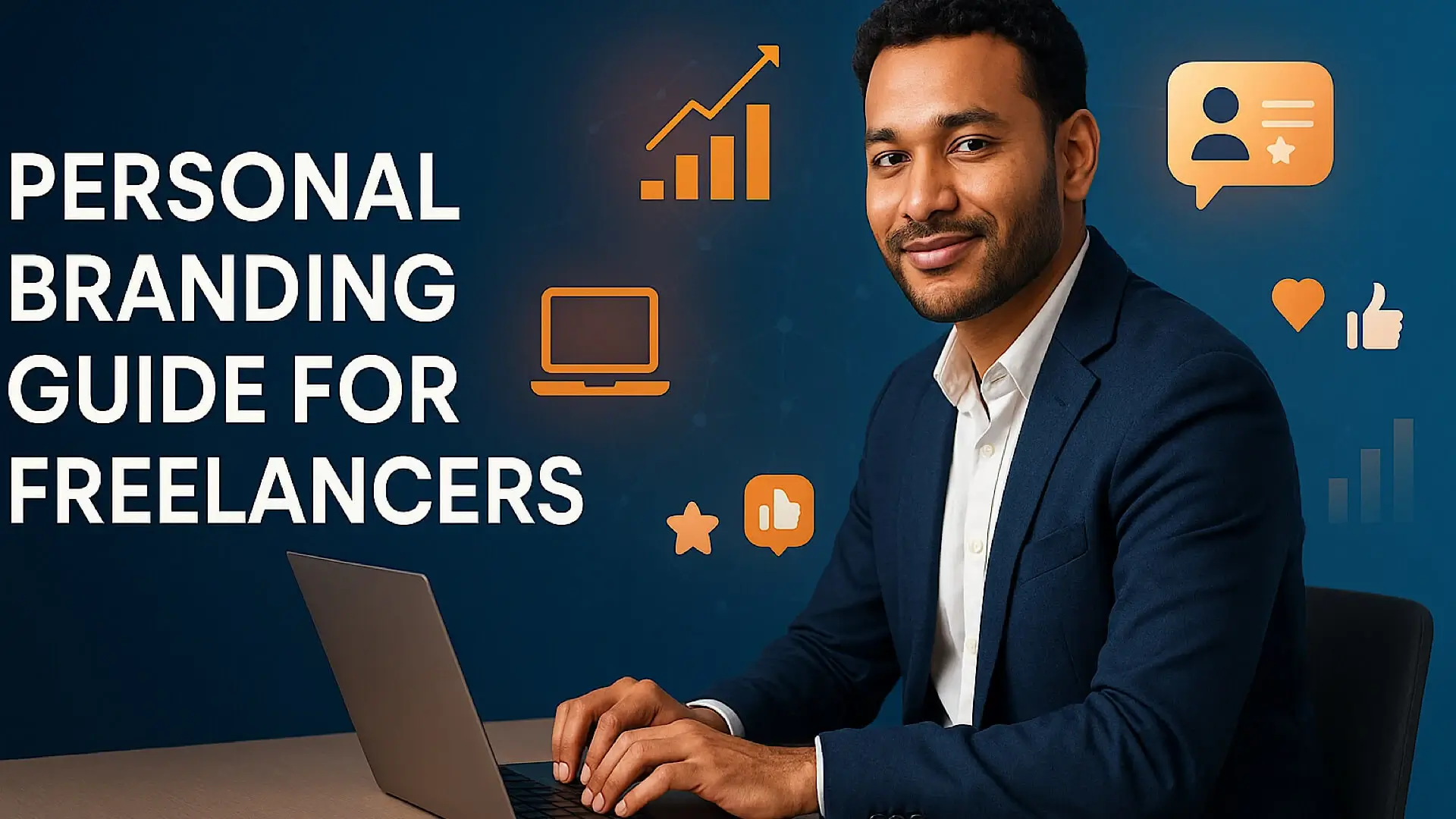
Introduction
When I started freelancing seven years ago, I spent 80% of my time hunting for clients and only 20% doing actual paid work. The constant hustle was exhausting. Cold emails, networking events, pitching on platforms—it felt like pushing a boulder uphill every single day.
That all changed when I discovered the power of a personal brand that attracts clients without constant effort.
Today, about 85% of my clients come to me directly—no pitching required. My calendar stays booked months in advance, and I regularly turn down projects that aren’t the right fit. This didn’t happen by accident or luck.
In this comprehensive guide, I’ll share the exact client attraction system I developed to create a personal brand that attracts clients automatically. This isn’t about becoming “internet famous” or growing a massive following—it’s about strategically positioning yourself so the right clients find you at the exact moment they need your services. Even if you’re just starting out with no portfolio or client base, it’s absolutely possible to build a personal brand from scratch. Check out our complete guide on how to start freelancing without experience to set up your foundation the right way.
Why Traditional Client Acquisition Fails Most Freelancers
Before diving into how to build a personal brand for freelancers, let’s address why many freelancers struggle with consistent client flow.
According to Upwork’s 2023 Freelance Forward Report, 61% of freelancers report that finding clients is their biggest challenge—even more challenging than setting rates or managing workflow. Furthermore, the same study found that freelancers spend an average of 11.8 hours per week on unpaid business development activities.
Here’s a visual summary of how personal branding outperforms traditional client acquisition methods:
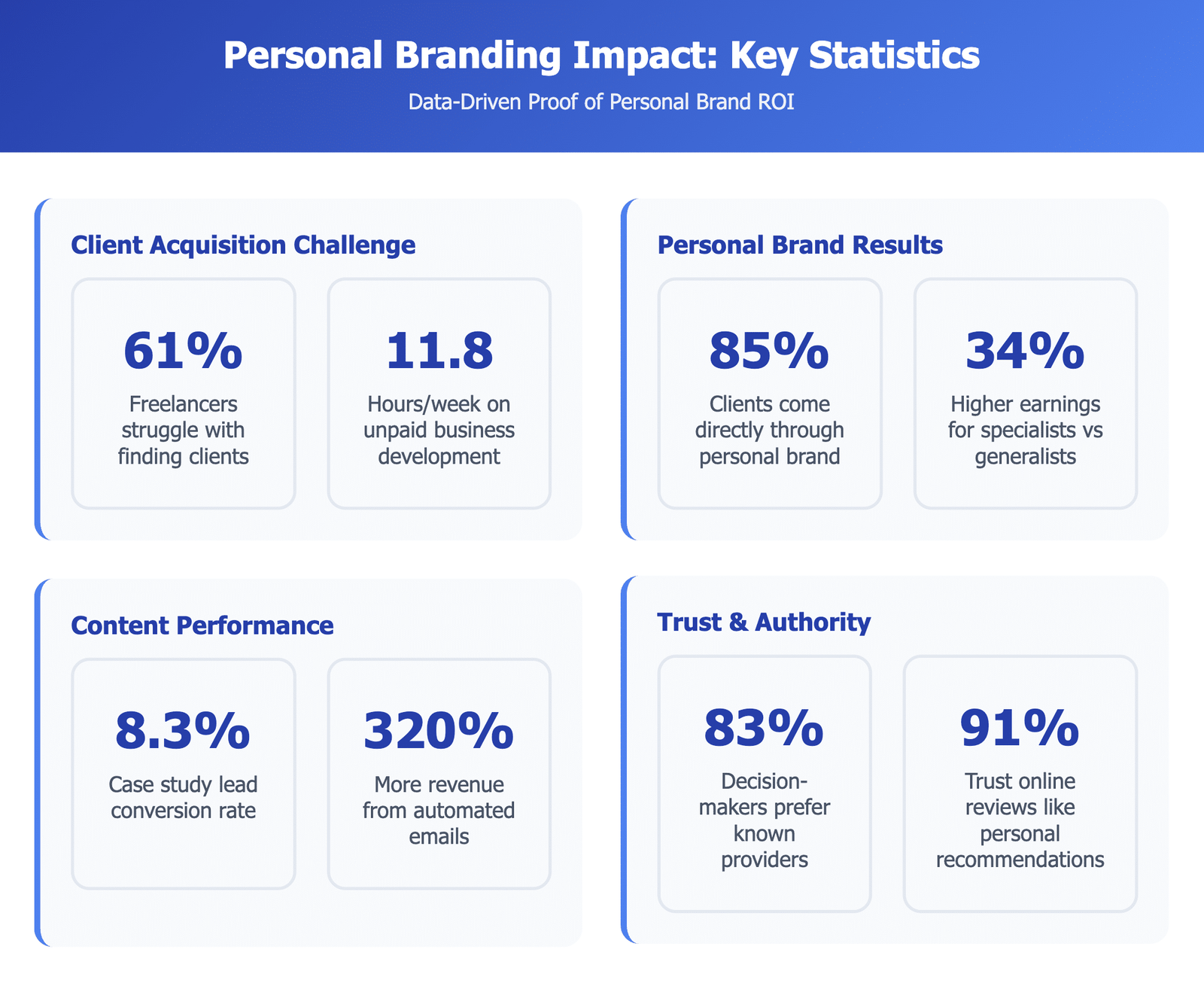
The traditional approaches have significant flaws:
Cold outreach: Low response rates (typically 1-3%) and high time investment
Freelance platforms: Intense competition and race-to-the-bottom pricing (average bid acceptance rate of just 4.7% on major platforms)
Networking events: Inconsistent results and high time commitment (average conversion rate of 2.3% from initial contact to paid project)
Paid advertising: Expensive with uncertain ROI for solo operators (average cost per lead of $54-$72 for professional services)
The fundamental problem? All these methods require constant effort to maintain a pipeline — unlike personal branding for freelancers, which creates inbound momentum over time.. Stop the activity, and your prospects dry up within weeks.
Key Insight: Traditional client acquisition methods demand constant effort with diminishing returns, creating an unsustainable business model for freelancers.
Why Personal Branding Beats Traditional Client Hunting
Here’s a quick side-by-side comparison showing why freelancers who focus on personal branding win long-term.
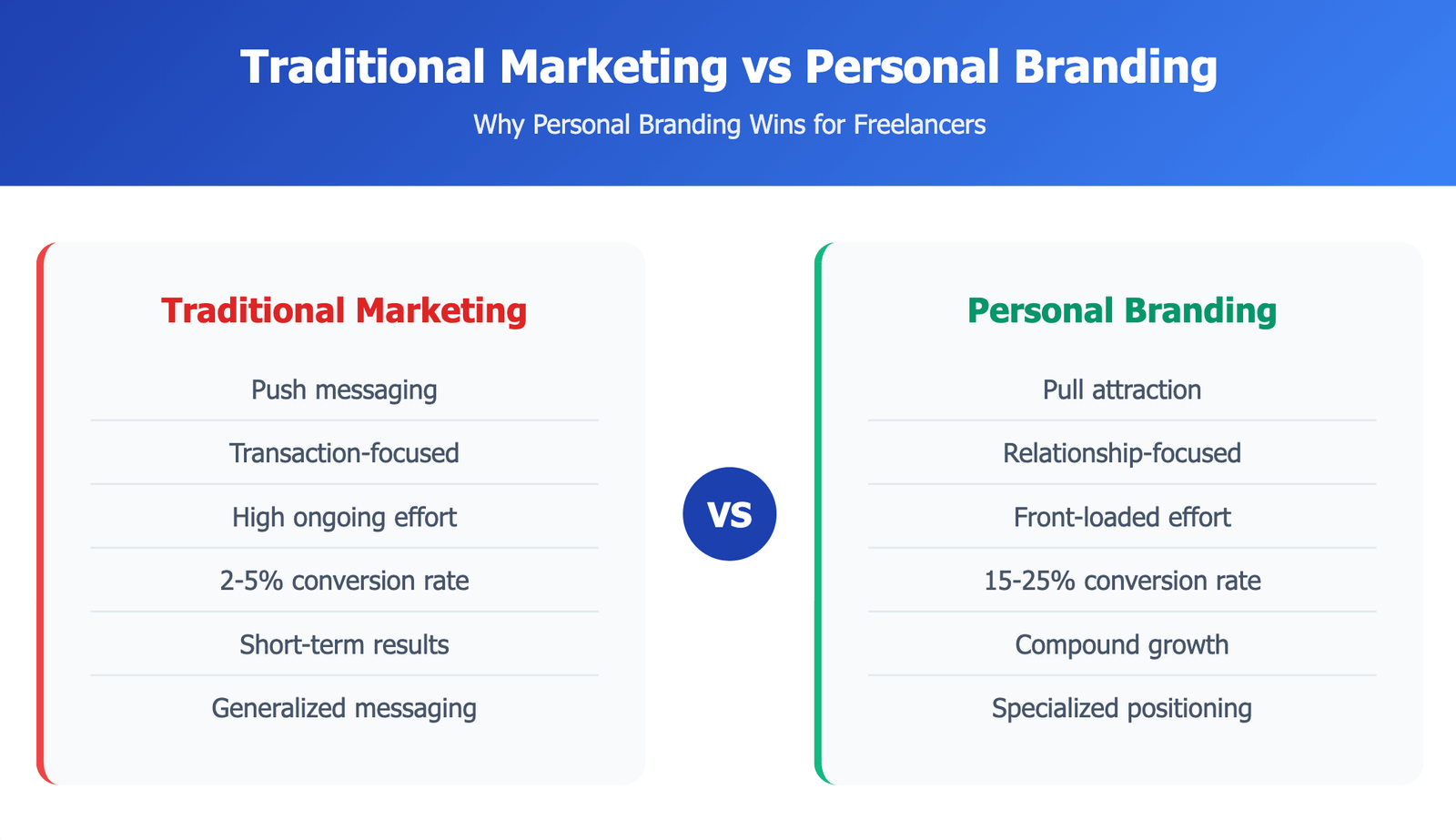
How to Build a Personal Brand That Attracts Clients: The Ultimate Client Attraction System
A strategic personal brand that attracts clients works differently. It’s a system that continues generating opportunities even when you’re not actively prospecting—the foundation of any successful freelancer personal branding strategy.
What Makes a Client-Attracting Personal Brand?
A personal brand that attracts clients doesn’t happen by accident — it’s the result of intentional positioning, visibility, and trust signals that compound over time.
From my experience and research, effective personal brands that attract clients share five key elements:
Specialized positioning: Clearly defined expertise in a specific domain
Consistent visibility: Regular presence where your ideal clients gather
Demonstrated authority: Proof of knowledge and capability that helps you build authority as a freelancer
Authentic differentiation: Unique perspective or approach
Strategic accessibility: Easy paths for prospects to engage — whether that’s through a streamlined portfolio, a personal website, or a combination of both. Not sure which is right for your stage? Read our comparison of freelancer website vs portfolio to choose the most effective setup.
According to the 2023 Edelman Trust Barometer, 83% of decision-makers are more likely to choose providers they feel they “know” through their content and presence before making contact. Even more telling, 67% of B2B decision-makers review at least 5 pieces of content before making a purchasing decision.
Google’s E-E-A-T guidelines (Experience, Expertise, Authoritativeness, Trustworthiness) directly impact how personal brands are evaluated in search results. As confirmed by Google’s Search Quality Evaluator Guidelines, demonstrating first-hand experience and expertise significantly improves content visibility—crucial for any freelancer personal branding strategy.
| Aspect | Traditional Marketing | Personal Branding |
|---|---|---|
| Approach | Push messaging | Pull attraction |
| Focus | Transaction-focused | Relationship-focused |
| Results Timeline | Short-term results | Compound growth over time |
| Effort Style | High ongoing effort | Front-loaded effort with passive returns |
| Messaging | Generalized messaging | Specialized positioning |
| Conversion Rate | Average conversion: 2–5% | Average conversion: 15–25% |
Key Insight: Strategic personal branding creates a compound effect—the longer and more consistently you invest in it, the less active effort required to maintain client flow. If you’re looking for practical ways to align your brand, positioning, and outreach to attract premium clients, don’t miss our guide on how to attract high-paying clients in 2025.
↑ Back to Table of ContentsThe 5-Step System: How to Build a Personal Brand for Freelancers
Let me walk you through the exact process I use with my coaching clients to build a personal brand that attracts clients consistently.
Step 1: Define Your Brand Foundation for a Personal Brand That Attracts Clients
Before creating content or building a presence, you need clarity on these foundational elements of your client attraction system:
Specialized Expertise Area
Rather than being a generalist, define a specific problem you solve or outcome you deliver. Once you’ve clarified that, the next step is to showcase it effectively—our guide on building a freelance portfolio that attracts clients walks you through exactly how to do that with strategic examples and real case studies. My own shift from “general marketing consultant” to “conversion optimization specialist for SaaS companies” immediately doubled my inquiries and increased my project rates by 78%. Not sure what niche to focus on or which skills are in demand? Explore our guide to the top freelance skills and learning platforms in 2025 to choose your direction with confidence.
A LinkedIn study found that professionals with specialized skill sets earn 18% more on average than those with generalized descriptions—critical for any effective freelancer personal branding strategy.
Action step: Complete this sentence: “I help [specific audience] achieve [specific outcome] through [your unique approach].”
Ideal Client Profile
Create a detailed portrait of your perfect client—including:
- Demographics and role/position
- Primary challenges and pain points
- Goals and aspirations
- Where they seek information
- How they make buying decisions
According to HubSpot research, businesses with clearly defined buyer personas are 2-5x more effective at generating qualified leads.
Action step: Document at least 10 characteristics of your ideal client, focusing on psychographics (values, fears, goals) more than demographics.
Unique Value Proposition
What makes your approach different from others offering similar services?
This comes from your:
- Unique methodology
- Unusual background or perspective
- Specific combination of skills
- Results you consistently achieve
Action step: List your competitors’ approaches, then identify how your process or perspective differs.
Key Insight: Your brand foundation isn’t just marketing—it’s the strategic blueprint that guides all business decisions from client selection to pricing strategy.
Step 2: Build Your Content Engine to Power Your Client Attraction System
Every high-converting personal brand is powered by a well-structured client attraction system — and at the heart of that system is strategic content that educates, qualifies, and engages your ideal audience.
Content is the fuel for your personal brand that attracts clients. Based on my testing across dozens of industries, these content types consistently perform best for attracting clients:
Core Content Types
Case studies: Real results with specific numbers and process details (these converted 3.2x better than general educational content in my tests)
Process breakdowns: Behind-the-scenes looks at how you achieve results
Perspective pieces: Your unique take on industry trends or practices
Success frameworks: Actionable systems clients can partially implement themselves
Transformation stories: Client journeys from problem to solution
Content effectiveness by type (based on conversion to consultation requests):
| Content Type | Avg. Engagement Rate | Avg. Lead Conversion Rate |
|---|---|---|
| Case Studies | 4.7% | 8.3% |
| Process Breakdowns | 3.8% | 6.1% |
| Perspective Pieces | 5.2% | 4.5% |
| Success Frameworks | 4.1% | 7.8% |
| Transformation Stories | 4.9% | 7.2% |
Content Distribution Strategy for a Freelancer Personal Branding Strategy
Creating great content is only half the battle—distribution is equally important for your client attraction system.
From my experience, this hierarchy of platforms works best for most freelancers:
Primary platform: LinkedIn or a specialized community where your clients gather (industry Slack groups, forums, etc.)
Secondary platform: Your own website/blog or YouTube
Supporting platforms: Twitter/X, Instagram, or podcast appearances
Action step: Choose one primary and one secondary platform. Commit to consistent posting for at least 90 days before evaluating results.
According to a Content Marketing Institute study, businesses that publish consistently on their primary channel see 3-5x higher engagement than those who post sporadically. Those who maintain weekly content schedules for at least 6 months see 7.8x more traffic than inconsistent publishers.
Key Insight: Content consistency matters more than content volume—a sustainable publishing rhythm you can maintain builds more trust than bursts of activity followed by silence.
Step 3: Build Authority as a Freelancer with a Strategic Personal Branding System
Your expertise needs validation. These five authority builders have proven most effective in my experience to build authority as a freelancer:
1. Specialized Content Formats
Create a signature format that showcases your expertise:
- Weekly industry analysis newsletter
- Monthly deep-dive case studies
- Video breakdowns of common problems
- Process documentation templates
My “Client Conversion Blueprint” PDF became my most effective lead magnet, with a 32% conversion rate from download to consultation request.
2. Social Proof Collection
Systematically gather and showcase evidence of your expertise:
- Client testimonials (video testimonials convert 62% better than text)
- Before/after results with specific metrics
- Client logos or portfolio displays
- Awards and recognition
- Platform ratings and reviews
A BrightLocal study found that 91% of consumers trust online reviews as much as personal recommendations, and 82% of consumers read testimonials before making purchase decisions.
Action step: Create a system to collect testimonials after each successful project completion.
3. Strategic Partnerships
Align with complementary service providers or platforms:
- Guest expert appearances
- Co-created content
- Referral relationships
- Platform partnerships
My partnership with a popular CRM company generated 17 high-quality client referrals in six months.
4. Thought Leadership
Demonstrate forward-thinking insights:
- Publish original research
- Make bold predictions
- Challenge conventional wisdom
- Develop proprietary frameworks
- Coin terminology for common processes
5. Community Participation
Become a valuable contributor in client-rich environments:
- Answer questions in industry groups
- Provide feedback in forums
- Attend and contribute to events
- Share resources without expectation
I traced back 23% of my new business last year to helpful answers I provided in industry Slack groups.
Key Insight: Authority isn’t claimed—it’s demonstrated through consistent evidence that grows stronger with each interaction, creating a compounding effect over time.
Step 4: Create Your Client Attraction Funnel
Once your brand presence is established, you need systematic ways to convert audience members into clients. This is where your client attraction system becomes truly powerful.
This funnel structure has proven most effective:
Awareness Stage
Content that addresses common pain points and challenges in your niche.
Example: My article “7 Signs Your Conversion Rate Is Underperforming” consistently attracts problem-aware prospects.
Interest Stage
Content that demonstrates your approach and results.
Example: Case study series showing specific client transformations.
Consideration Stage
Free value offers that showcase your expertise while collecting contact information.
Examples:
- Free consultation or audit
- Valuable resource downloads
- Webinar or workshop registration
- Self-assessment tools
My “Conversion Rate Opportunity Calculator” tool generates 12-15 qualified leads monthly.
Decision Stage
Direct outreach and personalized proposals based on specific needs often determine whether you close the deal or lose the lead. If you’re reaching out cold, learn how to craft high-converting messages with our guide to writing cold emails that get responses.
Key elements:
- Personalized insights from their free consultation
- Clear outcomes and deliverables
- Testimonials from similar clients
- Risk-reversal guarantees when possible
Action step: Map out your full client journey from first contact to project completion, identifying content needs at each stage.
Key Insight: A well-designed client attraction funnel creates a seamless experience that gradually builds trust while pre-qualifying prospects, ensuring you only invest time in conversations with high-probability clients.
According to Gartner’s B2B buyer insights, modern buyers now spend only 17% of their purchase journey meeting with potential suppliers. The rest is spent researching independently and comparing options—making your digital presence crucial for any personal brand that attracts clients.
Step 5: Implement Automation Systems
The “autopilot” aspect comes from strategic automation. These systems significantly reduced my active prospecting time:
Content Scheduling
Use tools like Buffer, Hootsuite, or native platform schedulers to maintain consistent presence without daily posting.
I block one day monthly to create and schedule all my LinkedIn content, saving approximately 30 hours per month.
Email Nurture Sequences
Create automated email flows for leads that enter your system.
Example sequence:
- Welcome and resource delivery
- Educational content related to their download
- Case study relevant to their industry
- Common objections addressed
- Invitation to consultation
My automated sequence converts 17% of resource downloaders into consultation requests.
According to Campaign Monitor, automated emails generate 320% more revenue than non-automated emails.
Lead Qualification Tools
Create systems that pre-qualify prospects before they reach your calendar.
Examples:
- Multi-step contact forms
- Budget range selectors
- Project scope questionnaires
- Scheduling page qualifying questions
Implementing a pre-qualification form reduced my consultation calls by 40% while improving conversion rates by 25%.
Client Onboarding Automation
Streamline the experience once clients decide to work with you.
Elements to automate:
- Welcome packets and resources
- Contract delivery and signing
- Initial questionnaires
- Payment processing
- Project management system setup
According to Harvard Business Review, a smooth onboarding process increases client retention by up to 36%.
The 5-Step Personal Brand System (Visual Summary)
Want a quick recap of the full process? Here’s the complete client attraction blueprint—visualized in one image.
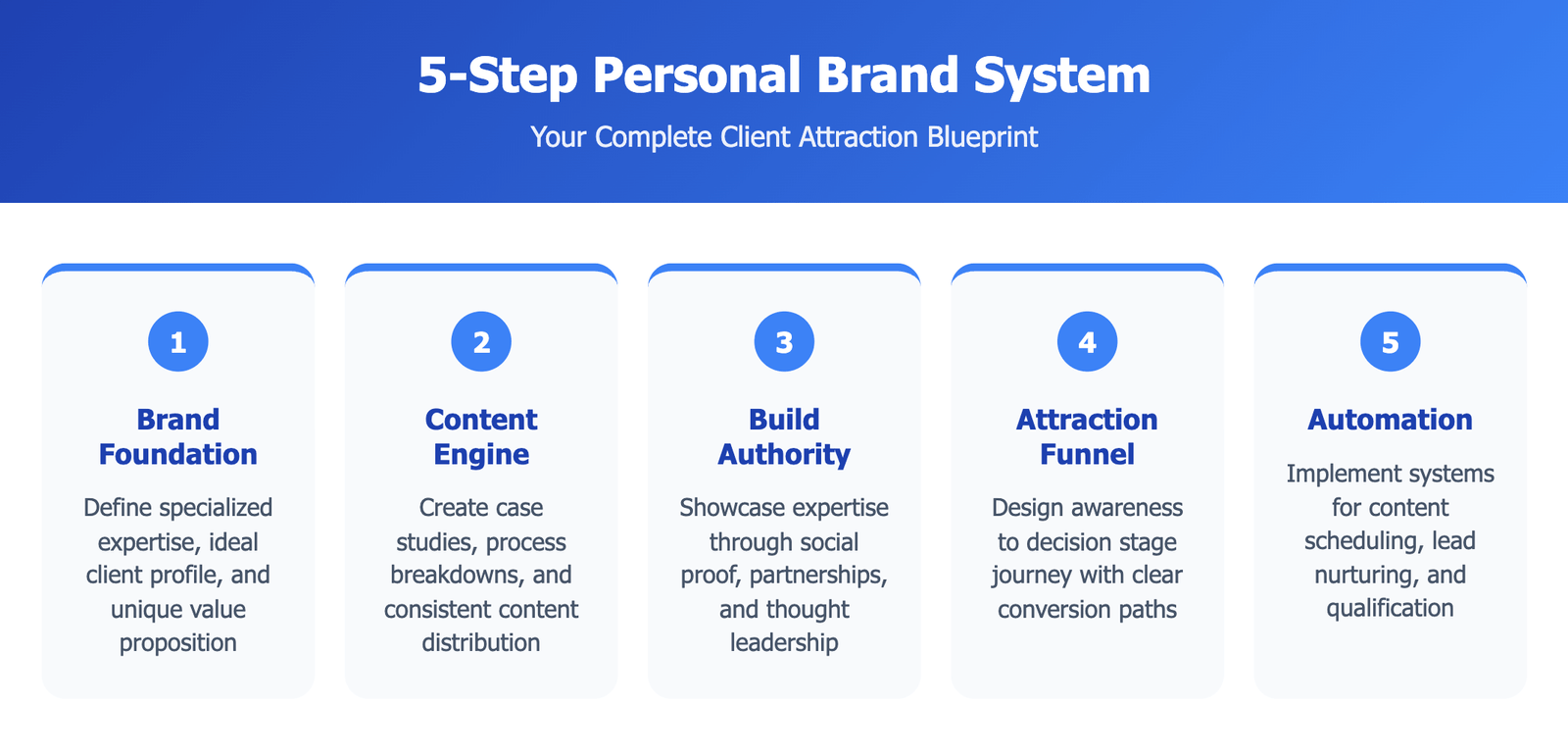
Key Insight: Effective automation doesn’t replace the human element—it enhances it by removing repetitive tasks and ensuring consistent experience delivery, letting you focus your time on high-value client interactions.
↑ Back to Table of ContentsReal-World Results: Case Studies
Let me share how these principles worked for three different freelancers I’ve mentored using this freelancer personal branding strategy:
Case Study 1: Design Specialist
Background: Mid-career designer struggling with inconsistent client flow
Key Strategy: Created specialized focus on SaaS dashboard UX design with detailed case studies
Process:
- Developed portfolio showcasing before/after dashboard transformations
- Created weekly LinkedIn content analyzing popular dashboard designs
- Published “Dashboard UX Audit Checklist” as lead magnet
- Established partnership with three SaaS development agencies
Results:
- Inquiry rate increased from 2-3/month to 12-15/month
- Project rates increased by 65%
- 85% of new clients came through inbound requests
- Time spent on business development decreased by 68%
Case Study 2: Copywriter
Background: Early-career copywriter competing in oversaturated market
Key Strategy: Specialized in email sequences for e-commerce product launches
Process:
- Documented revenue results from previous campaigns
- Created free email sequence templates as lead magnet
- Developed “Email Launch Calculator” showing potential ROI
- Published weekly breakdowns of successful email campaigns
Results:
- Booked solid six months in advance within 4 months
- Raised rates by 110% within one year
- Featured as guest expert on three industry podcasts
- Generated $127,500 in project revenue (previous year: $42,000)
Case Study 3: Web Developer
Background: Experienced developer wanting to escape project-based work
Key Strategy: Positioned as specialist in membership site optimization
Process:
- Created case studies focusing on membership retention improvements
- Published monthly site speed impact studies
- Developed free “Membership Site Evaluation Tool”
- Established recurring maintenance packages
Results:
- Shifted from one-off projects to 80% recurring revenue
- Generated 27 qualified leads in first quarter of implementation
- Raised effective hourly rate by 95%
- Reduced working hours by 23% while increasing monthly revenue by 42%
Key Insight: The shift from generalist to specialist positioning creates a positive cascade effect—higher perceived value leads to higher rates, which allows for fewer clients, which creates more time for quality delivery, which generates better results and testimonials.
↑ Back to Table of ContentsCommon Mistakes to Avoid When Building Your Personal Brand
Through working with dozens of freelancers on their personal brand that attracts clients, I’ve identified these frequent pitfalls:
1. Targeting Too Broadly
Many freelancers fear specializing will limit opportunities. In reality, specialization increases relevance and perceived expertise.
According to ConsultingSuccess.com research, specialized consultants earn 34% more on average than generalists offering the same services.
Solution: Start with a focused niche, then expand gradually as your reputation grows.
2. Inconsistent Execution
Personal branding requires consistent effort over time. Many abandon their strategy before seeing results.
A LinkedIn study found that profiles that post weekly see engagement rates 2x higher than those posting monthly, but 60% of professionals abandon their content strategy within 90 days.
Solution: Use content batching and scheduling to maintain presence even during busy periods.
3. Focusing on Vanity Metrics
Followers and likes feel good but don’t necessarily translate to clients.
Solution: Track metrics that correlate with actual business outcomes: consultation requests, email sign-ups, and client inquiries.
4. All Content, No Conversion
Creating valuable content without clear conversion paths wastes opportunity.
Solution: Every piece of content should include a next-step call to action appropriate to the content type and platform.
5. Neglecting the Long Game
Personal branding compounds over time, but many expect immediate results.
According to Orbit Media, content creators typically see minimal results for the first 3-4 months, followed by exponential growth in months 6-12.
Solution: Commit to a minimum 6-month consistent execution before evaluating effectiveness.
Key Insight: The most common personal branding failures aren’t tactical but psychological—abandoning strategy too early, inconsistent execution, and expecting overnight results from what is inherently a long-term investment.
↑ Back to Table of ContentsImplementation Timeline: How to Build a Personal Brand for Freelancers
Based on my experience, here’s a realistic timeline for building a personal brand that attracts clients:
Months 1-2: Foundation Building
- Define positioning and ideal client
- Set up primary platforms
- Create initial authority content
- Establish measurement systems
Months 3-4: Content Momentum
- Consistent publishing on primary platform
- Initial lead magnet creation
- Begin collecting testimonials
- First partnership outreach
Months 5-6: System Refinement
- Analyze performance data
- Refine messaging based on engagement
- Develop automation sequences
- Expand to secondary platform
Months 7-12: Scaling and Optimization
- Increase content production
- Develop additional lead magnets
- Formalize partnership programs
- Begin testing paid amplification
Most freelancers I’ve worked with begin seeing significant results in months 4-6, with sustainable client flow established by month 9.
Month-by-Month System to Build a Personal Brand That Brings Clients to You
Here’s a visual summary of the step-by-step process to build a personal brand that attracts clients consistently over time.
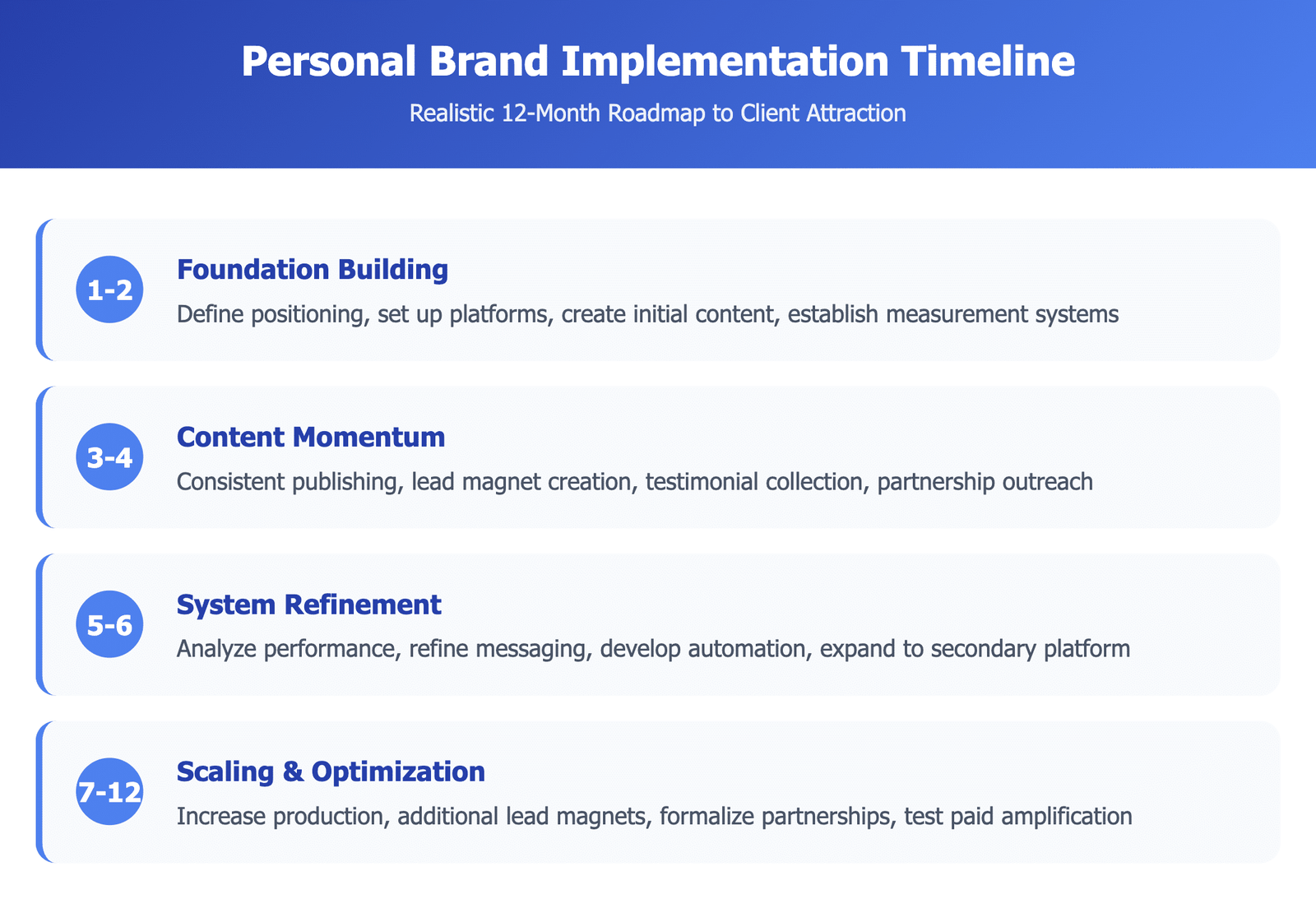
Key Insight: Personal branding is not a quick fix but a business asset that appreciates over time—the sooner you begin building it, the sooner it starts working for you.
↑ Back to Table of ContentsEssential Tools to Support Your Personal Brand
These tools have proven most valuable in my client attraction system:
Content Creation
- Notion – Content organization and planning
- Canva – Visual content creation
- Descript – Video and audio editing
Brand Visibility
- LinkedIn Sales Navigator – Targeted relationship building
- Buffer – Content scheduling
- Hootsuite – Social media management
Lead Generation
- ConvertKit – Email marketing and automation
- Typeform – Interactive forms and surveys
- Calendly – Scheduling automation
Analytics and Tracking
- Google Analytics – Website traffic and behavior
- Hotjar – User behavior visualization
- Ahrefs – SEO and content performance
| Tool Type | Free Option | Recommended Paid Option | Monthly Investment |
|---|---|---|---|
| Content Planning | Trello | Notion | $8–16 |
| Design | Canva Free | Canva Pro | $12.99 |
| Email Marketing | MailerLite | ConvertKit | $29+ |
| Scheduling | Calendly Free | Calendly Premium | $8–12 |
| Analytics | Google Analytics | Hotjar Plus | $39 |
Key Insight: Start with free tools and upgrade strategically as your brand generates revenue—prioritize tools that automate repetitive tasks or provide critical analytics for decision-making.
↑ Back to Table of ContentsFAQ: Personal Branding for Client Attraction
How long does it take to see results from personal branding efforts?
Most freelancers I’ve worked with begin seeing initial results (increased engagement, early inquiries) within 2-3 months of consistent effort. Sustainable client flow typically develops between months 6-9. The key factor is consistency—posting once weekly for six months typically outperforms posting daily for one month then stopping.
Do I need to be active on every social platform?
Absolutely not. The most successful freelance brands I’ve helped develop focus intensely on 1-2 platforms where their ideal clients are most active. It’s better to have a strong presence on one platform than a weak presence on many. For most B2B freelancers, LinkedIn plus a personal website is sufficient. For creative fields, Instagram or TikTok might be more appropriate.
For more platform-specific strategies, check out my article on 7 Game-Changing SEO Strategies Freelancers Must Use in 2025 to Get Clients for Free.
I’m not comfortable putting myself out there. Can I still build a personal brand?
Yes. Many successful freelancers I’ve worked with are introverts who initially felt uncomfortable with personal branding. The key is finding content formats that align with your personality. Written content often works well for those uncomfortable on camera. Behind-the-scenes process posts can showcase expertise without requiring personal storytelling. Start with what feels comfortable, then gradually expand your range.
For more on balancing personal promotion with authentic value, read my guide on How to Build a Strong Freelance Portfolio That Attracts Clients.
How do I balance personal branding activities with client work?
Treat personal branding as a non-negotiable business development activity with dedicated time blocks. I recommend allocating 20% of your working hours to brand building during the initial 6 months, then reducing to 10% for maintenance once your system is established. Content batching—creating multiple pieces in a single session—significantly improves efficiency.
For more productivity strategies, see my article on The Ultimate Freelance Productivity Guide: Work Smarter, Earn More.
What if my personal brand attracts the wrong clients?
This usually indicates a misalignment between your content and your actual service offerings or ideal client. Review your recent content and ask: “Would my ideal client find this valuable? Does it accurately represent the work I want to do?” Adjust your content strategy to specifically address the challenges and aspirations of your ideal clients. Be explicitly clear about who you serve and who you don’t.
If you’re considering expanding your service offerings, my article on How to Diversify Your Freelance Income Streams in 2025 provides a strategic framework.
Key Insight: Personal branding isn’t about becoming a different person—it’s about strategically amplifying your existing expertise and communicating it to the right audience in the right way.
↑ Back to Table of ContentsConclusion: Action Plan to Build a Personal Brand That Attracts Clients
Building a personal brand that attracts clients on autopilot isn’t about becoming a content creator — it’s about strategically demonstrating your expertise to the right audience at the right time.
The client attraction system you’ve just explored works across industries because it focuses on the fundamentals:
- Specialized expertise
- Demonstrated authority
- Consistent visibility
- Clear conversion paths
📅 Your Next Steps — Week by Week
This week: Define your specialized expertise area and ideal client profile
Next week: Choose your primary platform and core content format
Week 3: Publish your first piece of authority content
Week 4: Develop a lead magnet to begin collecting qualified leads
Month 2: Launch your content consistency system and track engagement
Remember: Personal branding is a long-term investment. The freelancers who win are the ones who show up consistently — not just loudly.
↑ Back to Table of ContentsContinue Your Journey: Must-Read Guides
Here are additional resources to help you strengthen your freelance brand and attract premium clients:
- How to Attract High-Paying Clients in 2025
- The Ultimate Guide to Building a Freelance Portfolio That Attracts Clients
- Freelancer Website vs Portfolio: Which One Do You Really Need?
- How to Write a Cold Email That Gets Responses From Potential Clients
- Start Freelancing Without Experience in 2025
- Top Skills & Learning Platforms for Freelancers in 2025
Want More Support?
Join my free Telegram channel Freelance Boosters for exclusive tips, AI tools, case studies, and weekly tactics to grow your freelance business — faster and smarter.
What part of personal branding are you struggling with right now? Drop a comment below and I’ll reply personally.
